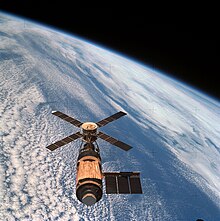Rumstation


Rumstationer er kunstigt skabte konstruktioner, der har til formål at tillade mennesker at leve i rummet udenfor Jordens atmosfære. En rumstation adskiller sig fra andre bemandede rumfartøjer ved ikke at have større selvstændig fremdriftssystem eller mulighed for at lande. I stedet bruges andre fartøjer til at transportere materiel og personer til og fra rumstationen. Rumstationer er designet til middel-lange ophold i rummet i perioder på uger, måneder og endda år.
Rekord for det længste ophold i rummet blev sat af Valeri Polyakov, der opholdt sig 437,7 dage om bord i Mir fra 1994 til 1995. I 2005 har i alt 3 personer haft enkeltophold i rummet på over 1 år – alle om bord i Mir.
Rumstationer gennem tiden
- Saljut-rumstationer: Saljut 1, Saljut 2 (mislykkedes, aldrig beboet), Saljut 3, Saljut 4, Saljut 5, Saljut 6, Saljut 7
- Skylab
- Mir
- Den Internationale Rumstation (ISS)
- Tiangong 1
- Tiangong 2
- Tiangong, Chinese space station (CSS)
Efter den kontrollerede nedstyrtning af Mir i 2001 var Den Internationale Rumstation den eneste af disse der på daværende tidspunkt var i kredsløb om jorden. Den har været bemandet uden pause siden 30. oktober 2000.
Tiangong fra det kinesiske rumprogram er også bemandet.[1]
Se også
- Dødsstjernen – fiktiv rumstation
- Transport
Referencer
Eksterne henvisninger
| Spire Denne artikel om rumfart er en spire som bør udbygges. Du er velkommen til at hjælpe Wikipedia ved at udvide den. |
Medier brugt på denne side
A drawing of NASA's Space Shuttle Challenger. Image provided by Dryden Flight Research Center at Edwards Air Force Base, California. See [1], specifically EG-0076-04.eps.
An overhead view of the Skylab Orbital Workshop in Earth orbit as photographed from the Skylab 4 Command and Service Modules (CSM) during the final fly-around by the CSM before returning home.
During launch on May 14, 1973, 63 seconds into flight, the micrometeor shield on the Orbital Workshop (OWS) experienced a failure that caused it to be caught up in the supersonic air flow during ascent. This ripped the shield from the OWS and damaged the tie-downs that secured one of the solar array systems.
Complete loss of one of the solar arrays happened at 593 seconds when the exhaust plume from the S-II's separation rockets impacted the partially deployed solar array system. Without the micrometeoroid shield that was to protect against solar heating as well, temperatures inside the OWS rose to 126°F.
The rectangular gold "parasol" over the main body of the station was designed to replace the missing micrometeoroid shield, to protect the workshop against solar heating. The replacement solar shield was deployed by the Skylab I crew.This is one of a series of digital still images of the International Space Station (ISS) recorded by the STS-110 crew members on board the Space Shuttle Atlantis following the undocking of the two spacecraft some 247 statute miles above the North Atlantic. Atlantis pulled away from the complex at 1:31 p.m. (CDT). After more than a week of joint operations between the shuttle and station crews, astronaut Stephen N. Frick, pilot, backed Atlantis away to a distance of about 400 feet in front of the station, where he began a 1 1/4 lap flyaround of the ISS, newly equipped with the 27,000 pound S0 (S-zero) truss, visible in this series of images. S0 is the first segment of a truss structure which will ultimately expand the station to the length of a football field.



